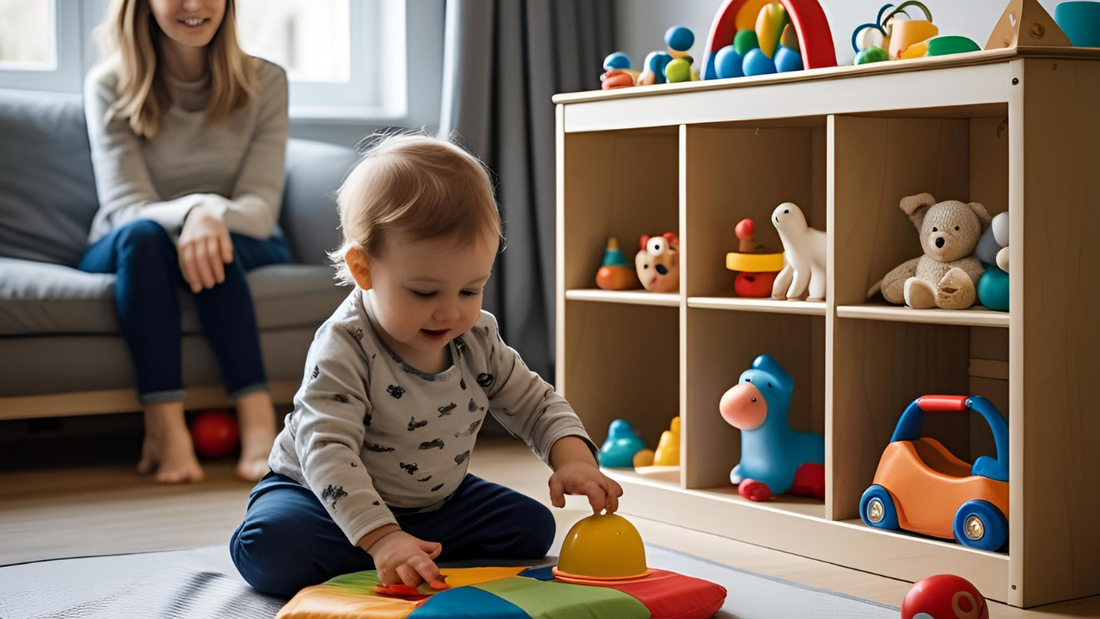
How to Set Up a Simple Play Area That Encourages Independent Play!
LiLLBUDImagine this: While you enjoy a hot cup of coffee, your toddler is contentedly playing by themselves. Does that sound dreamy? It's completely possible, and no, an elaborate playroom or overflowing toy bins are not necessary.
The secret? A thoughtfully designed toy shelf setup that sparks curiosity, encourages independent play in toddlers, and grows with your child.
This guide will assist you in creating a nurturing, clutter-free environment where your child can flourish, regardless of whether you're a carer looking for realistic, peaceful playtime routines or a new parent choosing toys for a one-year-old.
1. Keep Things Simple: Less Is More
Let's begin here: An excessive number of toys leads to excessive stimulation. When all of their toys are available at once, toddlers frequently feel overloaded. Rather, provide a changing assortment of four to six carefully selected items:
- A Montessori-style ring or stacking toy (refer to the below link for such toy ideas: https://www.lillbud.com/products/leaning-tower-stacking-blocks)
- A plush animal or doll
- A few toys for brain development, such as shape sorters (https://www.lillbud.com/products/shape-surprize-box)
- A basket or sensory bin filled with organic textures
- A board book
- Silent pretend play items (scarves, spoons, and cups)
- For a curated kit for a 12 month old, refer to the below link: https://www.lillbud.com/products/learning-leaps-12-to-14-months-all-rounder-kit
Parent Tip: This setup actually encourages longer play sessions because your child can focus - leading to deeper learning.
2. Rethink How You Arrange Your Toy Shelves
Expensive furniture is not necessary. Only a play mat, open baskets, and a low shelf. Accessibility is the main objective because toddlers will naturally seek out toys that are visible and within easy reach. Here's how to organise it:
- Rotating "main attraction" toys on the top shelf
- Open-ended play (blocks, Montessori toys) on the middle shelf
- Bottom shelf: Safe products for tummy time, such as sensory balls or non-toxic toys (Refer to the below link for such toy ideas on our website): https://www.lillbud.com/products/starry-crinkle-mat
Why this works: Children feel more at ease, self-assured, and capable when there is order and simplicity, which reflects Montessori principles.
3. Adopt Toy-wise Arrangement Advice
Bid farewell to the endless toy bin! Instead, arrange toys in shallow trays or open containers according to type. For instance:
- Sensory balls in one basket
- Wooden blocks on one tray
- Pretend food in one box
Use basic images to identify baskets visually. This also encourages independence when it comes time to clean up.
4. Make Use of Toys That Promote Brain Development
Let's talk about toys that do more than just amuse; these are known as brain development toys. Look for:
- Nesting cups (using spatial reasoning)
- Chunky puzzles or pop beads (fine motor)
- Use scarves or stack rings to practice cause-and-effect play.
- Various-textured, non-toxic tummy time toys for safe exploration
Open-ended materials are GOLD. Your child can use their imagination when they play with toys that don't "do the work" for them.
5. Create Room for All Stages, Especially for Young Children
Your play space should accommodate significant developmental milestones such as crawling, standing, and cruising if your child is one year old.
- Mouthing and grasping
- Imitating real life actions
- Create secure, floor-friendly areas with: Soft Montessori toys for gripping
- Push-pull items
- Basic musical instruments
- Just eye level visual components
Keep it calm, easy, and safe.
6. Spark Play with Kind Invitations
Give your toddler a small "starter scene" to explore:
- Create a zoo with a basket filled with blocks and two animals.
- Start a meal with a plate of fictitious vegetables.
- Time to spin with two scarves!
Without you having to explain or guide, these arrangements serve as open invitations that pique curiosity.
Toddlers who engage in independent play adore it when they find the magic for themselves.
7. Honour the Play, Even if It's Only for Five Minutes
Step back once your toddler is actively participating. Avoid interrupting. Don't give too much praise. Simply watch and applaud their focus.
Five minutes is still real play, so start small. Their endurance will naturally increase with time. Try stating: "You were really focused! What were your toys up to?
Final Thoughts: Your Simple Setup Can Lead to Significant Growth
Raising an independent thinker doesn't require a nursery that looks like it belongs on Pinterest. Your child will learn a lot and start playing on their own with a well-planned toy shelf arrangement, some clever toy organisation advice, and a dash of faith.
So, start small, be consistent, and see how your toddler thrives with play that is both enjoyable and brain-building.
- Have enquiries?
- Do you need assistance selecting safe, non-toxic tummy time toys or sensory toys?
- We would LOVE to see your play area setup, so please leave a comment below or tag us in it!

